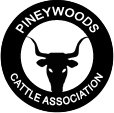Pineywoods cattle are an important genetic resource for the deep south, but will only continue to be important if they are carefully bred and maintained. Purity is important. The Pineywoods is one of a handful of Iberian-derived breeds. Through quirks of history they were brought to Mississippi and adjoining states. The Iberian root of the breed is important, because Iberian cattle are unlike cattle anywhere else in the world. They come from an old, old African and European root. The importance of this is that crossbreeding works extremely well with them, but you need the purebreds to produce those crossbreds! Any contamination of the pure resource leads to decreases in production on down into the future. We need to guard the breed purity jealously.
When buying Pineywoods cattle, be sure to evaluate the cattle and the story behind them. Buy from reputable breeders, and buy registered cattle. In the old days of herds of 1500 or so, multiple bulls in a herd made sense. In today’s world it is best to have single bulls, and for pedigrees to be carefully kept. That is the key to maintaining this breed into the future.
Be suspicious of herds that run Pineywoods cows with multiple bulls, especially if those bulls include any that are not Pineywoods. Depending on breed, and on your ability to detect crossbreeding, the calves may or may not be purebred. Use your eyes and your brain—the looks of the herd should match the story that is told. If it does not, something is wrong with the story!
Some breeders do crossbreed, and there is nothing wrong with that as long as crossbreds do not make it into the registry. The few breeders that track crossbreds have also produced calves that are 3/4 Pineywoods, and in many cases these are very close matches to purebred Pineywoods cattle. The lesson here is that it is important that ONLY Pineywoods bulls be used on Pineywoods cows if the calves are destined to be registered as purebreds. Any crossbreds should be carefully identified, and all males castrated and sold for beef.
Occasionally breeders will encounter good candidate cows in sale barns. The one-off cow that turns up is suspect, unless the herd of origin is known and some of the history of the herd is known. The odd single cow that “looks right,” coming through a local sales barn, is a huge risk to the breed and to the breeder. A cow from a herd with the right history, looks, and background is important to the breed, and it is important to find these whenever we can. But, the essential element here is that the herd should be evaluated, and the history should make sense. It is always best to evaluate a herd rather than an individual animal. Individual animals can fool you, while herds can do that only rarely or never. These “surprise” cows that are purebred are increasingly rare, and most of the purebred Pineywoods cattle are now in documented herds.
With careful attention to breeding and buying in cattle, this breed can continue to make contributions on into the future.
